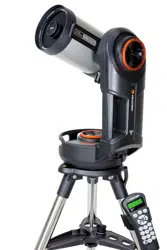Loading ...
Loading ...
Loading ...

ENGLISH I 21
Your NexStar Evolution telescope requires little maintenance. There are a few things to remember that will ensure your
telescope performs at its best.
TELESCOPE MAINTENANCE
DEW PREVENTION
Schmidt-Cassegrain telescopes are especially susceptible to condensation forming on the front corrector lens because the
glass is immediately exposed to the outside air, just like the windshield on your car. If the temperature outside drops below the
dew point, dew may form on the corrector within minutes.
The easiest way to prevent dew is to add an optional dew shield, available from Celestron, which shrouds the corrector and
keeps the air immediately surrounding the corrector slightly warmer than the ambient temperature. If conditions are more severe,
a dew heater, commonly available from other manufacturers, can be added to apply slight heat to the corrector lens to keep it
dry all night.
If dew has already formed on the corrector, point the telescope downward and allow the telescope to dry. You can also use a
hairdryer to heat the corrector and evaporate the moisture to dry the telescope.
Dew does not harm the telescope, but can lead to faster dust build up. You should only cap the telescope when it’s dry. Do not
store the telescope if covered in dew. Allow the telescope to dry first.
Occasionally, dust and/or moisture may build up on the corrector plate of your telescope. Special care should be taken when
cleaning any instrument so as not to damage the optics.
If dust has built up on the corrector plate, remove it with a brush (made of camel’s hair) or a can of pressurized air. Spray at
an angle to the lens for approximately two to four seconds. Then, use an optical cleaning solution and white tissue paper to
remove any remaining debris. Apply the solution to the tissue and then apply the tissue paper to the lens. Low pressure strokes
should go from the center of the corrector to the outer portion. Do NOT rub in circles!
You can use a commercially made lens cleaner or mix your own. A good cleaning solution is isopropyl alcohol mixed with
distilled water. The solution should be 60% isopropyl alcohol and 40% distilled water. Or, liquid dish soap diluted with water (a
couple of drops per one quart of water) can be used.
If moisture condenses on the inside of the corrector, remove the accessories from the rear cell of the telescope. Place the
telescope in a dust-free environment and point it down. This will remove the moisture from the telescope tube.
To minimize the need to clean your telescope, replace all lens covers once you have finished using it. Since the rear cell is
NOT sealed, the cover should be placed over the opening when not in use. This will prevent contaminants from entering the
optical tube.
Internal adjustments and cleaning should be done only by the Celestron repair department. If your telescope is in need of
internal cleaning, please call the factory for a return authorization number and price quote.
CARE AND CLEANING OF THE OPTICS
The optical performance of your telescope is directly related to its collimation. Collimation is the alignment of the optical
system. Your Schmidt-Cassegrain telescope was collimated at the factory after it was completely assembled. However, the
telescope may have to be collimated after it’s transported. The only optical element that may need to be adjusted, or is
possible, is the tilt of the secondary mirror.
To check the collimation of your telescope you will need a light source. A bright star near the zenith is ideal since there is
a minimal amount of atmospheric distortion. Make sure that tracking is on so that you won’t have to manually track the star.
Or, if you do not want to power up your telescope, you can use Polaris. Its position relative to the celestial pole means that it
moves very little thus eliminating the need to manually track it.
Before you begin the collimation process, be sure that your telescope is in thermal equilibrium with the surroundings. Allow
45 minutes for the telescope to reach equilibrium if you move it between large temperature extremes.
To verify collimation, view a star near the zenith. Use a medium to high power eyepiece. It is important to center a star in the
center of the field to judge collimation. Slowly move in and out of focus and judge the symmetry of the star. If you see a
systematic skewing of the star to one side, then re-collimation is needed.
COLLIMATION
Loading ...
Loading ...
Loading ...
